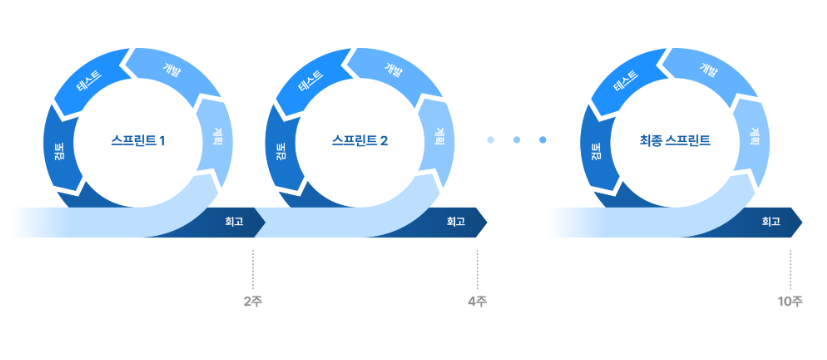1.jpg)
Many companies around the world adopt Agile methodology, but few have been successful because it is not just a tool or process change, but a paradigm shift that changes the mindset of executives and employees. In particular, managers and middle managers who are familiar with traditional methods can feel a great deal of rejection from the Agile philosophy. Nevertheless, we have prepared for companies and organizations that want to flexibly respond to rapid market changes and introduce Agile to increase their organizational productivity. With two series of contents, we will learn how to introduce enterprise-wide Agile and how to form a high-performance team!
[Preview of the series]
① Companywide Agile: Sequential Methods for Successful Deployment
② High Performance Team: Action Guide for Team Spirit Formation (→ We're Here Now!)
5 Principles for Creating Agile High Performance Team
The Agile High-Performance Team refers to a high-performing team based on the Agile methodology. How can we build a High-Performance Team?
1. team members with intrinsic motivation
According to Edward L. Deci's theory of self-determination, people have intrinsic and extrinsic motives. Extrinsic motivation means working to receive rewards or incentives, and intrinsic motivation means doing the work because the act itself is enjoyable. When the intrinsic motivation is full, you can expect passion and creativity with strong persistence. Agile basically encourages team members to have intrinsic motivation. If you team up with enough intrinsic motivation, you can achieve fast growth and the best performance.
2. clear goals, standards, and autonomy
Set clear goals and deadlines, but guarantee autonomy within them. Leaders should support their team members to choose and take responsibility for the tasks they want and provide various learning opportunities.
3. active feedback in a respectful atmosphere
You should be able to give honest feedback in a respectful atmosphere among your team members. Close feedback naturally allows you to fine-tune yourself and become more immersed in the project. Through regular sprint retrospectives, we explore ways to make your team work more efficient and enjoyable and improve your team's work environment.
4. an atmosphere of active dialogue and cooperation
You should create an atmosphere of acknowledging and praising the hard work of your team members, even if it is small. Leaders should ask appropriate questions rather than advice to help their team members think and judge themselves. Just listening to your team members can boost your team's morale. In addition, leaders and team members should hold 1:1 meetings periodically to properly understand their difficulties.
5. Team Spirit Formation
When a culture of cooperation is created in which I believe that my colleagues will cooperate with me when I need help, the team's output will automatically increase. This is because cooperation has the effect of increasing synergy rather than competition. You must create an atmosphere in which you are willing to help your team members to achieve their common goals.
Servant Leadership Building Agile High Performance Team
Servant leadership, in a word, refers to leadership that supports team members' growth. Leaders are leadership styles that are dedicated to achieving team goals, which can have a very positive impact on the Agile team. Seven leadership characteristics suggested by servant leadership expert Dr. Lee Kwan-eung are as follows.
① Leaders position their team members as volunteers to help them solve problems and grow.
② Keep in mind that the most valuable resource in your team is 'people'.
③ The leader must show an attitude of learning first so that team members can participate.
④ Listen to your team members first and encourage them with conversations that can motivate them.
⑤ Persuade in a horizontal atmosphere and build consensus through dialogue.
⑥ Encourage collaboration so that team members can have deep ties with each other.
⑦ Share leadership by delegating some authority to your team members.
The biggest advantage of servant leadership is that it creates an environment where team members can freely challenge themselves without fear of failure. This is because it creates an important psychological stability for the Agile team to improve quickly through experiments and feedback. Team members learn from their mistakes and take the next action quickly and flexibly to achieve better results.
How to Use Agile by PLATEER groobee
The groobee division, which makes AI personalized tech solution groobee, has been planning, developing, and distributing new services through the Agile-based "PI Planning" process since this year. PI planning is a work method used in Agile methodology, which refers to a group of teams gathering to set common goals to achieve for a certain period of time and planning what to do to achieve those goals. When each team decides what to do in PI planning, the team members will proceed with the work according to the following procedure.

⁕ PI Planning: Listing functions, discussing tasks and setting schedules for each team
⁕ Sprint: 5 sprints in every 2 weeks (Plan > Development > Test > Review > Retrospective)
⁕ System Demo: Demonstrate features created in 10 weeks to all members, gather feedback
⁕ Feature Deployment: New Groovy Feature Deployment of Features Passed System Demos
Once the feature deployment is over, we restart PI planning to think about better features and services to start another sprint.

Subscribe to our newsletter



